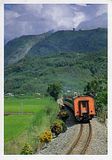

 The Sinaia Monastery was founded by Prince Mihai Cantacuzino in 1695 and named after the great Sinai Monastery on Mount Sinai. As of 2005 it is inhabited by 13 Christian Orthodox monks led by hegumen Macarie Bogus. It belongs to the archdiocese of Bucharest. Situated in the Prahova Valley, the Monastery has given its name to the dwellings nearby. Those few houses have turned into the town of Sinaia, in Prahova County, Romania. The monastery consists of two courtyards surrounded by low buildings. In the centre of each courtyard there is a small church built in the Byzantine style. One of them - "Biserica Veche" (The Old Church) - dates from 1695, while the more recent "Biserica Mare" (The Great Church) was built in 1846. The monks possess a library that constitutes a repository for valuable jewels belonging to the Cantacuzino family, as well as the earliest Romanian translation of the Bible, dated 1668. Here is buried Take Ionescu, former Prime Minister of Romania.
The Sinaia Monastery was founded by Prince Mihai Cantacuzino in 1695 and named after the great Sinai Monastery on Mount Sinai. As of 2005 it is inhabited by 13 Christian Orthodox monks led by hegumen Macarie Bogus. It belongs to the archdiocese of Bucharest. Situated in the Prahova Valley, the Monastery has given its name to the dwellings nearby. Those few houses have turned into the town of Sinaia, in Prahova County, Romania. The monastery consists of two courtyards surrounded by low buildings. In the centre of each courtyard there is a small church built in the Byzantine style. One of them - "Biserica Veche" (The Old Church) - dates from 1695, while the more recent "Biserica Mare" (The Great Church) was built in 1846. The monks possess a library that constitutes a repository for valuable jewels belonging to the Cantacuzino family, as well as the earliest Romanian translation of the Bible, dated 1668. Here is buried Take Ionescu, former Prime Minister of Romania.Prince (Spătarul) Mihai Cantacuzino founded the monastery upon his return from a pilgrimage to Mount Sinai. It took five years to complete the first buildings from 1690 to 1695. It was supposed to serve as a Monastery as well as a fortified stronghold on the way from Brașov to Bucharest. In the first plan the Monastery will hold 12 monks just like the Twelve Apostles, but, in time, the number of monks grew.
During the Russo-Turkish War, 1735-1739 the Monastery was deserted and the valuables hid inside a bell and buried. During that war the Turks have fought a battle with the troupes stationed within the walls of the Monastery and won. The ottomans had burned the area and broke the wall in two places. Until 1850, Sinaia consisted of little more than the monastery and a group of huts. In 1864, however, the monastic estate was assigned to the Board of Civil Hospitals (Eforia Spitalelor Civile), which opened a hospital and several baths, and helped develop mineral springs in Sinaia.
In 1948 the Monastery goes under the patronage of the Archdiocese of Bucharest from the Board of Civil Hospitals. The Romanian Patriach Justinian restores the buildings between the years 1951 and 1957 with the money from the Archdiocese of Bucharest. At this point they fit the whole Monastery with running water, electricity and natural gas.
The Old Church was built in 1695. As of 2006 it is currently closed and it is restored to the old beauty. The original painting is made by Pârvu Mutu and restored for the first time in 1795. Celebratin 200 years of the Old Church in 1895 they opened the Museum of the Monastery. This is the first exhibition of church objects in Romania.



.jpg)



























No comments:
Post a Comment